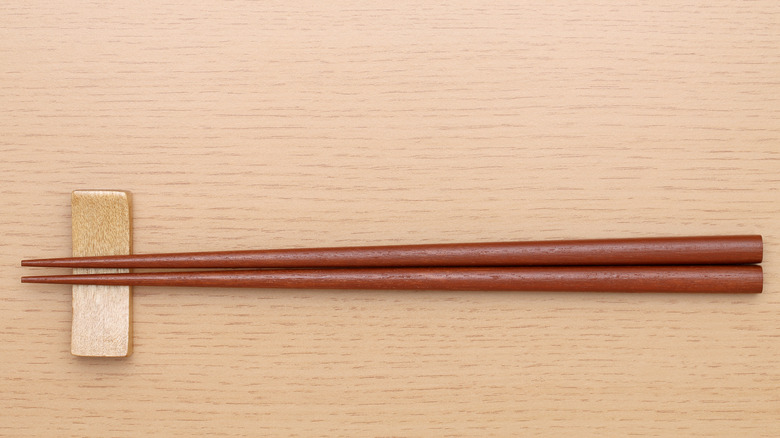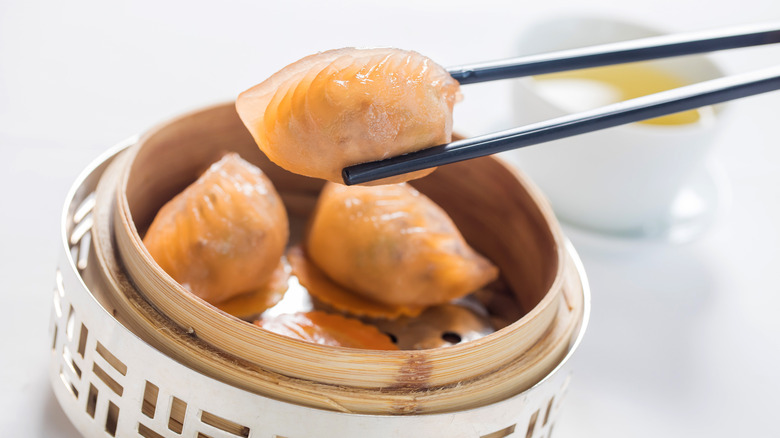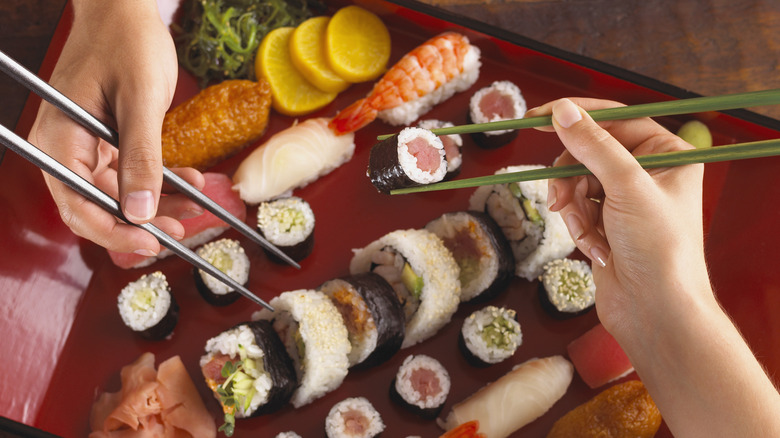The Clever Reason Chopsticks Are Slanted
Even if you eat with chopsticks on a regular basis, you likely pay little attention to the design of these tools. They're just a couple of sticks, right? In reality, not all chopsticks are the same. Look more closely, and you might see that wooden takeout chopsticks are thicker from end to end, while fancier lacquered versions you find at a sushi restaurant taper into narrow points. This slanted shape doesn't just look elegant — it also has a functional purpose.
Chopsticks with slanted tips are commonly used in Japanese culture. The narrow ends work almost like tweezers, helping you pick up small, delicate foods like short-grain sticky rice or pull out tiny fish bones, which you'll encounter in many Japanese dishes. In contrast, a wider tip works for picking up chunks of Hunan-style stir-fried beef or thick noodles, but isn't quite as precise.
In Japan, you might also see chopsticks with tapered tips at both ends. In a modern sense, this allows diners to use the different ends for foods whose flavors may not pair well together, but historically, double-tipped chopsticks have a special meaning. Called ceremonial chopsticks, these tools were not used for everyday dining, but instead to share foods with immortal deities. Chopsticks with two functional ends were said to allow gods to partake in meals alongside ordinary men. The Japanese word for chopsticks, "hashi," is a homonym of the word for "bridge," symbolizing their connection to the spiritual realm.
Other cultures use different chopstick designs
While Japanese chopsticks usually have tapered ends, the same cannot be said for chopsticks from other cultures. Traditional Chinese chopsticks are usually thicker with a blunt end, and the earliest versions date back to around 1200 B.C. Their rise to ubiquity could have been influenced by the highly-renowned philosopher Confucius. According to legend, the famed wiseman rejected eating utensils with sharp ends, as he associated them with violence. Instead, he sought out blunt-tipped utensils like bamboo chopsticks, which later become popular across the country.
Chopsticks used in Chinese cuisine are often longer than Japanese ones, allowing diners to easily reach across the table and pick from various dishes as they share meals with family. The Chinese word for chopsticks, "kuàizi," loosely translates to "fast sticks," which you undoubtedly need when eating the same dishes as your competitive siblings, or at a family reunion where food tends to disappear quickly.
Meanwhile, Korean-style chopsticks are usually more flat in shape, and are often used in conjunction with a spoon at most meals. Instead of wood, bamboo, or plastic, they're commonly made of metal. Many point to the material as the reason behind the flatter shape, as rounded metal chopsticks take more effort to craft than sticks that can be simply stamped flat.
Japanese chopsticks come with their own set of etiquette
Whether you're dining at an everyday Japanese restaurant or using ceremonial-style chopsticks at a new year's feast or tea ceremony, you should follow certain rules of etiquette. For instance, you should never rub chopsticks together, as this behavior may insult your host by implying their utensils are of cheap quality.
Similarly, you should never pass food from your chopsticks to someone else's chopsticks. This action mimics a practice of Japanese funeral rituals, in which the deceased's bones are passed around by mourners using ceremonial chopsticks. Sticking your chopsticks in rice in an upright position mimics another funerary tradition, and is therefore considered to be bad luck.
Most Japanese restaurants also provide chopstick rests, which you should always use when setting down your chopsticks. Lacking a chopstick rest, carefully place your chopsticks on the edge of your dish, not directly on the table. Be sure to place the sticks side-by-side and never crossed. Do not play with your chopsticks or chew on them, and never use them as a skewer or knife. A good rule of thumb is to pretend the ends of your chopsticks are attached, so that they can't be separated — this helps you avoid multiple faux pas related to arranging or using them incorrectly.



